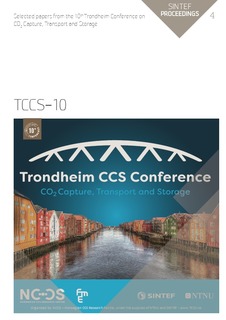| dc.contributor.author | Nygård, Heidi S. | |
| dc.contributor.author | Meyer, Julien | |
| dc.contributor.author | di Felice, Luca | |
| dc.contributor.author | Eldrup, Nils Henrik | |
| dc.contributor.author | Haug, Alf Tore | |
| dc.contributor.author | Olsen, Espen | |
| dc.date.accessioned | 2020-01-27T08:30:01Z | |
| dc.date.available | 2020-01-27T08:30:01Z | |
| dc.date.issued | 2019 | |
| dc.identifier.isbn | 978-82-536-1646-9 | |
| dc.identifier.issn | 2387-4295 | |
| dc.identifier.uri | http://hdl.handle.net/11250/2637952 | |
| dc.description.abstract | Carbon Capture in Molten Salts (CCMS) is a method for capturing CO2 from a variety of flue gases related to power generation and energy intensive industry processes. The chemical principles are similar to those of the calcium looping process in solid state (using CaO-based solid sorbents), where CO2 is captured in a carbonation reaction to form CaCO3, and then released through the reverse calcination reaction in a second step. In the CCMS concept, the novelty is to operate the process in the liquid state in CaO-rich molten salts. The formed CaCO3 dissolves continuously in the melt, thus leaving highly reactive CaO readily available for the incoming CO2. In the present study, the technical and economic feasibility of the CCMS process has been investigated for capturing CO2 from metallurgical ferro-silicon (FeSi) production using relevant industrial parameters. We have evaluated a generic plant based on one of the existing 40 MW FeSi furnaces the company Elkem owns and operates, but with theoretical considerations regarding recycling of the flue gas with the purpose of recovering energy. The input parameters for the capture process are based on experimental data. With the assumption of 85 % CO2 capture and CO2 compression to 70 bar (at 20 oC), the capture cost is estimated to be 60 EUR/ton, indicating that CCMS is a promising competitive alternative technology for fullscale CO2 capture for FeSi production. The main cost driver for the process has been identified as the cost of desorption. The desorber has a high investment cost, and also requires high temperature heat transfer for operation. However, the evaluations show that the introduction of an integrated system with combustion and heat pipes is a viable technical option. | |
| dc.language.iso | eng | |
| dc.publisher | SINTEF Academic Press | |
| dc.relation.ispartof | Proceedings of the 10th Trondheim Conference on CO2 Capture, Transport and Storage ; TCCS-10, 2019 | |
| dc.relation.ispartofseries | SINTEF Proceedings;4 | |
| dc.rights | CC BY NC ND | |
| dc.rights.uri | http://creativecommons.org/licenses/by-nc-nd/4.0/ | |
| dc.subject | CCMS | |
| dc.subject | Techno-economic study | |
| dc.subject | FeSi production | |
| dc.title | Techno-Economic Study of the CCMS Technology for CO2 Capture From Ferro-Silicon Production | |
| dc.type | Chapter | |
| dc.type | Conference object | |
| dc.type | Peer reviewed | |
| dc.description.version | publishedVersion | |
| dc.rights.holder | © The authors. Published by SINTEF Academic Press 2019 This is an open access publication under the CC BY-NC-ND license | |
| dc.subject.nsi | VDP::Teknologi: 500 | |
| dc.relation.project | Norges forskningsråd: 617270 | |

